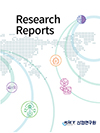Research Reports

In 2005, the Korea Institute for Industrial Economics and Trade (KIET) conducted a study, “Vision 2020 for the Development of Korean Industries”, exploring what Korean industry in the 2020s might look like. Nearly 15 years later, there is a need to look at the future of Korean industry again. Reflecting recent issues in the global economy, Major countries are seeking out new strategies for future industrial development. In Korea as well there is a need for a shift in the economic paradigm, as weak potential growth stemming from economic maturity is continuously observed, andits industrial structure ? which heavily depends on main industries and conglomerates faces structural limitations.
Given these assumptions, this study aims to prepare and present a milestone for a future-oriented industrial development plan for Korean industries that reflects global mega-trends. This study has been compiled into three volumes. The first volume deals with industrial sectors as a whole and consists of six chapters, including an introduction.
In Chapter 2 of the first volume, in order to investigate the impact of mega-trends on Korean industrial sectors, 11 mega-trends are selected. The implications of this analysis are as follows. In all analyses of importance, likelihood, impact, and big data, it is of unquestionable, vital importance that the fourth industrial revolution be considered in establishing a future outlook and development strategy. After all, not only the introduction and utilization of technologies related to the fourth industrial revolution, but also changes in the socio-economic structure and even the occurrence of new problems should be noted. Changes in population and household structure, energy and environmental issues and China also need to be considered. Changes in GVC and world trade patterns as they relate to Korean industrial sectors are not high on their own but should be addressed in terms of their linkages with other mega-trends.
Chapter 3 deals with overseas industrial development strategies in response to mega-trends, focusing on the United States, Germany, Japan, China and the EU. Although the roles of government in each country’s industrial development strategy differs, the degree of government intervention in the development of high-tech manufacturing industries has increased compared to the past. Developed countries present their final plans after sufficient discussion in the public and private sectors when preparing strategies, and emphasize the role of the private sector as the main actor in their strategies.
Chapter 4 studies the history of Korean industrial development and issues surrounding future industrial development and labor. In the 2000s the industrial and corporate strategies that worked well in the past became less effective. In particular, the performance of both individual companies and entire industries began to decline sharply in the 2010s. As the private sector expands and the complexity of production and innovation networks grows, the effectiveness of government-led industrial development strategy - with the exception of a handful of industries - has been greatly diminished. In addition, to upgrade the industrial development plan of the past, which was focused on the manufacturing sector, we should not ignore the importance of devising development strategies for the service sector, considering it accounts for the largest share of production and employment, and thus has the potential to create new value through the utilization of fourth industrial revolution technologies. Meanwhile, labor issues facing the Korean economy currently and in the future include the relatively low wages at small and medium-sized enterprises and new issues arising from mega-trends including the contraction of the labor supply and the increase of the proportion of middle-aged workers.
In Chapter 5, a vision for industrial development through 2030 was derived and it serve as a basis for the policy suggestions. In the process of forecasting industrial structure, our own model (KIET-DIMM) was updated and utilized. According to the forecast, manufacturing is projected to account for 28.5 percent of the economy in innovation scenarios by 2030, with the service sector representing the remaining 64.3 percent. Considering the industrial development process of advanced countries and the progress of servicification, the service sector is likely to expand as a proportion of the overall economy while manufacturing declines somewhat. However, due to the characteristics of Korean economy ? which is heavily dependent on the manufacturing sector it is likely that such a decline will occur gradually rather than rapidly. Finally, Korea’s industrial development vision for 2030 is dubbed “Robust Industry 2030: New Value Creator”, the goal of which is to upgrade industry through a full-scale transformation of industrial innovation systems and frameworks. Key strategies include Smart Manufacturing, Agile Industry and a Dynamic and Inclusive Ecosystem.
Chapter 6 presents a series of policy agendas for our vision for 2030. The main content is as follows. First, it is necessary to upgrade current industrial policy to an industrial policy, which encompasses other sectors within the economy and helps to expand new value-generating capabilities. The second policy agenda concerns human capital investment and the establishment of an innovation environment that emphasizes the importance of fostering a talented labor force. The third is securing original technologies and establishing a development system for pre-emptive technology. The fourth is related to the establishment a win-win industrial ecosystem which includes securing a healthy ecosystem through fair competition rules, shifting policy design to create an open ecosystem, and strengthening policies to enhance the innovation capabilities of small and medium enterprises. The fifth policy agenda is about revising industrial policy to reflects the GVC of the future, which means we should identify our competitiveness through our role and status in the global value chain. The sixth policy direction addressed the Korean smart manufacturing strategy for utilizing opportunities in the fourth industrial revolution. Policy directions related to service sector innovation strategies are also provided. The seventh suggested policy agenda is improving the efficiency of the Korean service sector through accelerating the economy’s progress toward a platform economy. Finally, we finish chapter 6 by emphasizing the need for a grand social compromise for the successful implementation of the policy agenda that was drawn up. We reviewed the Dutch Bassenaar Convention and the German Hartz Reforms cases and examined the conditions that our society should bear in mind in trying to reach a social compromise.
The second and third volumes present future prospects and development strategies for individually-selected industries in the manufacturing and service sectors.

The works on this page are licensed for fair use under the provisions of the Korea Open Government License. See kogl.or.kr for more information.
Please enter the security text below
to prevent email collection
Please check the information of the person in charge.
연구과제 제안이 접수되었습니다.
신청이 접수되었습니다.


View Summary
코로나19 발생 이후 대부분의 고용 관심사가 항공 및 여행서비스, 음식·숙박 서비스 등 주로 서비스 업종에 집중된 상황에서 본 연구는 최근 그 중요성이 강조되고 있는 제조업의 고용변화를 살펴보았다. 분석에 따르면, 코로나19 이후 제조업 고용은 비교적 큰 충격 없이 빠르게 회복하는 모습을 보이고 있다. 제조업 고용은 서비스업에 비해 큰 충격 없이 유지되고 있고, 코로나19 직후 2020년 상반기에 약간 하락하였지만 하반기부터 회복 추세를 보이고 있으며, OECD 주요국의 제조업과 비교하여도 일본과 함께 고용 충격이 비교적 작게 나타나고 있다. 그러나 전반적으로 양호한 고용 성적에도 불구하고 제조업 내 특성 별로는 차이가 나타나는 것으로 보인다. 종사상 지위 별로 보면, 임시·일용직, 고용원이 있는 자영업자에서 고용 충격이 상대적으로 크게 나타났고, 상용직과 고용원이 없는 자영업자는 큰 충격이 없는 것으로 나타났다. 제조업 규모별로는 300인 이상의 경우 코로나 발생 초기 약간의 충격 이후 고용이 빠르게 반등하면서 코로나 이전보다 고용이 더 증가한 반면, 이보다 작은 규모의 제조업체들의 경우 고용 회복이 더디게 나타나고 있다. 고용의 중장기, 단기 추세선을 비교한 결과 제조업 업종에 따른 차이를 보였다. 코로나 발생 이전 3년간의 추세선을 2020년 1월부터 연장한 선과, 2020년 1월부터의 실제 자료를 이용한 단기 추세선을 비교한 결과, 의약품은 코로나19 발생 이전부터 시작하여 코로나19 발생 이후에도 견조한 증가세를 유지하고 있으며, 전자부품·컴퓨터, 기타운송장비, 가구는 코로나19 이후 오히려 고용 추세가 개선되었다. 그러나 다수 업종은 코로나 발생 이후 고용이 하락하였는데, 특히, 비금속광물, 1차금속, 금속가공 분야나 인쇄·기록매체 업종에서 하락이 상대적으로 크게 나타났다.
The following information is provided.
inform@kiet.re.krPlease complete the CAPTCHA below.
[전지적키에트시점] (Eng sub)심상치 않은
국내 대기업 움직임??
KIET 시점에서 보는 미래 로봇 산업 전망은
어떨까요?
경제전문가가 알려드립니다!
(산업연구원 박상수 실장)


